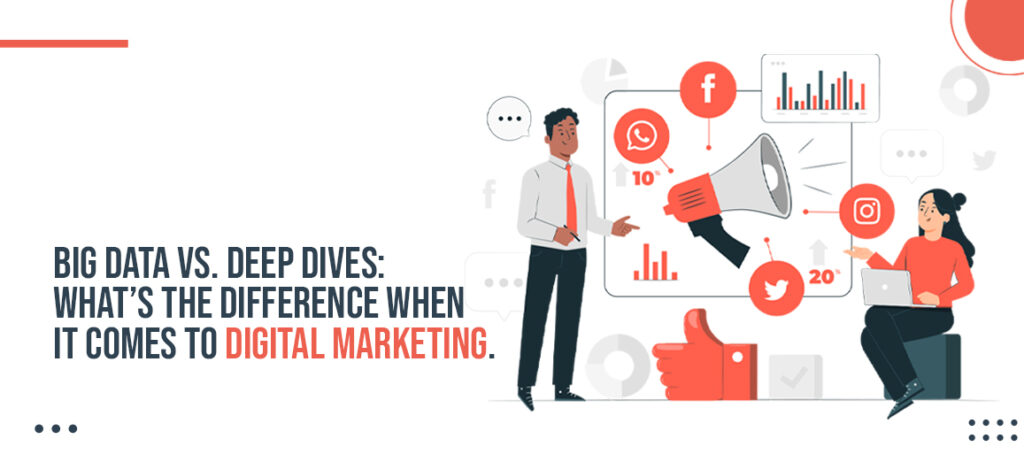Effective utilization of data is essential for success in the ever-changing field of digital marketing. Talking about data-driven methods frequently brings up the terms “Big Data” and “Deep Dives.” Comprehending the differences between these ideas is essential for marketers who want to fully use their digital methods.
Big Data: A Quick Overview
Big Data refers to the vast volume of information generated at an unprecedented speed and variety.
This data is typically too immense for traditional processing methods to handle efficiently. In digital marketing, Big Data encompasses a wide array of information, including customer behavior, social media interactions, website analytics, and more.
Marketers leverage Big Data to derive valuable insights and patterns, helping them make informed decisions.
This data-driven approach enables personalized targeting, dynamic content creation, and real-time adjustments to campaigns. Big Data empowers marketers to understand overarching trends within their audience but may lack the depth needed for granular insights.
Deep Dives: A Quick Overview
Contrastingly, Deep Dives involve a more focused and in-depth analysis of specific aspects within the broader dataset. Rather than exploring the entire spectrum of Big Data, Deep Dives plunge into particular segments or variables. This method allows marketers to extract detailed insights, uncover hidden opportunities, and address specific challenges.
In the context of digital marketing, a Deep Dive could involve scrutinizing the performance of a specific campaign, analyzing the behavior of a segmented audience, or evaluating the effectiveness of a particular channel. By delving deeply into these specifics, marketers can refine strategies, optimize performance, and enhance overall campaign effectiveness.

Choosing the Right Approach
First let’s talk some stats:
-
Big Data Penetration:
- Statistic: Over 80% of businesses incorporate Big Data in their digital marketing strategies.
-
Deep Dives Impact:
- Statistic: 72% of marketers report that Deep Dives into specific data segments have positively influenced their campaign performance.
-
Big Data Challenges:
- Statistic: 65% of businesses face challenges in managing and extracting actionable insights from their Big Data.
-
Deep Dives Precision:
- Statistic: Deep Dive analysis leads to a 15% improvement in campaign precision and targeting accuracy.
-
ROI Enhancement with Big Data:
- Statistic: Businesses leveraging Big Data for marketing see an average ROI increase of 25% compared to those without such strategies.
-
Strategic Decision-Making:
- Statistic: 88% of CMOs believe that a combination of Big Data analytics and Deep Dives is essential for effective and strategic decision-making in digital marketing.
The choice between Big Data and Deep Dives hinges on the marketing objectives and the nature of the insights needed.
Big Data provides a panoramic view, ideal for understanding overarching trends and patterns. On the other hand, Deep Dives offer a microscopic examination, beneficial for refining strategies and addressing targeted challenges.
In an ideal scenario, a harmonious integration of both approaches can create a robust and comprehensive data strategy. Utilizing Big Data for overarching insights and employing Deep Dives for detailed optimizations, marketers can strike a balance that maximizes the impact of their digital initiatives.
The detailed comparison is given in the table below:
| Feature | Big Data | Deep Dives |
| Scope | Broad analysis of large, diverse datasets | Focused analysis of smaller, targeted datasets |
| Data Source | Internal and external sources, often aggregated (e.g., website traffic, social media data, CRM) | Specific campaigns, customer groups, or user journeys |
| Analysis methods | Statistical models, machine learning, artificial intelligence | Qualitative research, user interviews, surveys, customer feedback |
| Key Findings | General trends, patterns, and insights | Detailed user motivations, behaviors, and pain points |
| Actionable insights | Inform long-term strategies, resource allocation, and product development | Drive immediate campaign optimization, content creation, and personalization |
| Resources required | Technical expertise, specialized tools, and infrastructure | Relatively affordable, less technical expertise needed |
| Time to insights | Can be lengthy, requiring iterative analysis and interpretation | Can be obtained quickly, often within days or weeks |
| Examples | Analyzing customer segments across all channels to identify high-value groups, predicting churn rate using website behavior data | Studying customer reviews of a new product launch to understand specific pain points and areas for improvement |
| Strengths | Uncover hidden patterns, predict future trends, inform strategic decisions | Deeply understand customer motivations, personalize experiences, optimize ongoing campaigns |
| Weaknesses | Can be overwhelming, lack of actionable insights without proper interpretation, data quality issues | Limited scope, may not reveal broader trends, potential for confirmation bias |
Anecdotal Studies Vs. Big Data Studies in Digital Marketing
In digital marketing research, anecdotal studies and big data studies represent two distinct approaches, each offering unique insights and methodologies.
Understanding the differences between these approaches is crucial for marketers seeking to extract meaningful and actionable information.
-
Anecdotal Studies
Anecdotal studies involve the collection and analysis of individual, often firsthand, accounts, experiences, or observations. These narratives provide a qualitative perspective, offering depth and context to understand consumer behavior.
In digital marketing, anecdotal studies might involve direct interviews, surveys, or user testimonials. While these studies can be valuable for understanding individual experiences, preferences, and sentiments, they are inherently limited in scale and may lack the statistical robustness of larger datasets.
Big Data Studies
On the contrary, big data studies rely on the analysis of vast volumes of structured and unstructured data. This approach involves leveraging advanced analytics tools to extract patterns, trends, and correlations from massive datasets.
In digital marketing, big data studies might include the analysis of user interactions on websites, social media engagement, and online purchasing behavior. This quantitative approach provides a broader, statistical understanding of consumer trends, enabling marketers to make data-driven decisions on a larger scale.
Key Differences
- Scale and Volume: Anecdotal studies are small-scale and qualitative, focusing on individual experiences. In contrast, big data studies deal with large datasets, providing a more comprehensive and quantitative perspective.
- Context vs. Trends: Anecdotal studies emphasize context and depth, offering insights into individual experiences. Big data studies, on the other hand, focus on identifying trends and patterns within large datasets, enabling marketers to make informed decisions based on broader consumer behaviors.
- Statistical Validity: While anecdotal studies may lack statistical validity due to their small sample sizes, big data studies provide statistically significant insights, offering a more reliable basis for decision-making.
Well, both anecdotal studies and big data studies play integral roles in the digital marketing research landscape. Anecdotal studies offer depth and context, while big data studies provide scale and statistical robustness.
A strategic combination of both approaches allows marketers to derive comprehensive insights and make informed decisions tailored to their audience’s needs and preferences.
What’s the Final Verdict?
digital marketing, data functions as the compass that directs strategic choices. Marketers need to select the appropriate strategy based on their goals, whether they are navigating the overwhelming ocean of Big Data or delving deeply into certain insights. Ultimately, the foundation of an effective, flexible, and data-driven digital marketing strategy is the synergy between Big Data and Deep Dives.





